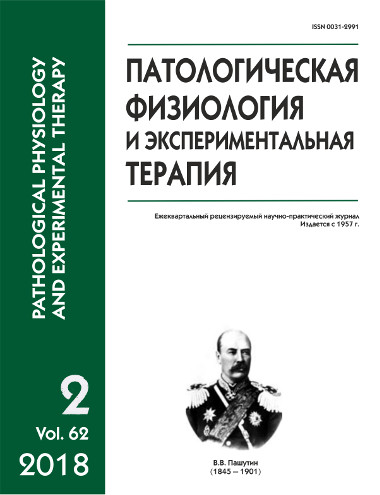Analysis of interrelation between immunoregulatory, neuromediator, and autonomic parameters during formation of psychoactive substance dependence
Abstract
Aim. To investigate the relationship between psychophysiological and immunoregulatory indexes at different stages of forming psychoactive substance dependence. Methods. The study involved 347 subjects, including patients with psychiatric and behavioral disorders caused by psychoactive substances (233 subjects); occasional users of psychoactive substances (28 subjects); and subjects without apparent disease (84 subjects). Immunoglobulins, cortisol, neurotransmitters, and antibodies to neurotransmitters were determined by enzyme-linked immunosorbent assay (ELISA). Subpopulations of immunocompetent cells were identified by flow cytometry. Electrocardiogram, photoplethysmogram, and parameters of skin electrical activity were recorded using the BOSLAB Professional software and hardware complex. Anxiety and aggressiveness were evaluated using the Spielberger-Khanin and Buss-Durkee tests, respectively. Statistical analyses were performed using the Statistica software. The Mann-Whitney test was used for intergroup comparisons. Factorial models were constructed using the principal component method. The models included standardized, normally distributed characteristics. Distribution normality was verified by Kolmogorov-Smirnov and Shapiro-Wilk criteria. Results. The most pronounced changes in neurotransmitter, immune, psychological characteristics, and parameters of the sympathoadrenal system were observed in patients with the psychoactive substance dependence syndrome. Such patients were characterized by increased production of all neurotransmitter antibodies associated with reduced blood levels of dopamine. This is a typical immune imbalance with deficiency of the cell component and stimulation of the humoral component, multidirectional shifts in the sympathoadrenal system, and progressive anxiety and aggression. Consumers of psychoactive substances with adverse consequences associated with a tendency to increase blood levels of serotonin showed an increased relative count of lymphocytes with a shift in the autonomic balance toward the parasympathetic activity. Conclusions. Factorial models indicated that the contribution of changes in the production of neurotransmitter antibodies to the dispersion of model parameters was the greatest. In patients, immunoregulatory, autonomic and psychological reactions changed independently of each other whereas in individuals without apparent disease and occasional users, tighter interrelations of these reactions were observed.
Downloads
References
2. Hahn C., Kim D.J. Is there a shared neurobiology between aggression and Internet addiction disorder? J Behav Addict. 2014; 1: 12-20.
3. Simonovska N, Zafirova-Ivanovska B, Babulovska A, Pereska Z, Jurukov I, Trenchevska-Siljanovska L.Influence of Duration of Heroin Dependence on Humoral Immunologic Indicators. J Addict Med. 2016; 10: 448-52.
4. Patkar O.L., Belmer A., Holgate J.Y., Tarren J.R., Shariff M.R., Morgan M. et al. The antihypertensive drug pindolol attenuates long-term but not short-term binge-like ethanol consumption in mice. Addict Biol. 2017; 3: 679-91.
5. Davydova T.V., Vetrilje L.A., Nevidimova T.I., Vetlugina T.P., Fomina V.G., Zaharova I.A. et al. The ratio of antibodies to neurotransmitters in the blood serum of students who occasionally used psychoactive substances. Bulleten' eksperimental'noy biologii i meditsiny. 2014; 3: 309-11. (in Russian)
6. Davydova T.V., Vetrilje L.A., Nevidimova T.I., Fomina V.G., Masterova E.I., Bohan N.A. et al. Antibodies to dopamine and glutamate as predisposing factors to addictive disorders. Sibirskiy vestnik psikhiatrii i narkologii. 2016; 2: 39-41. (in Russian)
7. Vetrilje L.A., Nevidimova T.I., Masterova E.I., Bohan N.A., Zaharova I.A., Savochkina D.N. et al. Antibodies to neurotransmitters are neuroimmune markers in the personalized prevention of dependence diseases. Patologicheskaya fiziologiya i eksperimental'naya terapiya. 2017; 1: 31-7. (in Russian)
8. Bohan N.A., Masterova E.I., Nevidimova T.I., Savochkina D.N. Regularities of psychoneuroimmunological response in individuals at different stages of the formation of dependence on psychoactive substances. Voprosy narkologii. 2017; 2-3: 117-27. (in Russian)
9. Masterova E., Bokhan N., Nevidimova T., Savochkina D., Nikitina V., Lobacheva O., Vetlugina T. Role of olfactory reactions, nociception, and immunoendocrine shifts in addictive disorders. American Journal on Addictions. 2017; 6: 640-8.






